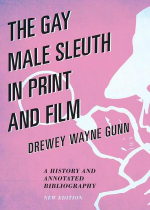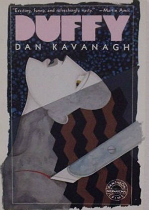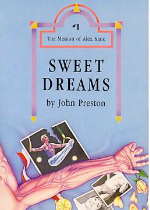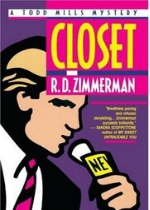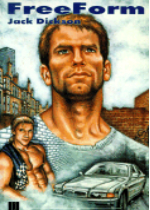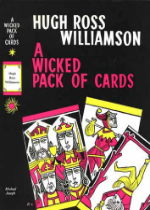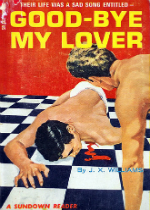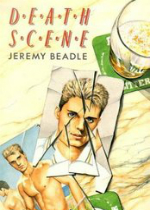GunnShots: Celebrating Great Gay Mysteries
Author: Drewey Wayne Gunn
January 7, 2013
Culture critic Jillian Steinhauer has an online article “127 Reasons Why We’re Fascinated by Lists” (The Awl, 7 Feb. 2012). She notes that list-making is “an act of curation,” and she quotes Andrew Sarris that, “with a 10-best list, a critic puts his or her tastes on the line.” But nowhere among her 127 reasons does she argue that celebration can be a motive. Yet isn’t that what was going on at the end of the last century when we got lists of the 100 best of everything imaginable? A personal celebration led to this column. The day before (appropriately enough) Thanksgiving, my copies of the new and expanded edition of my book The Gay Male Sleuth in Print and Film: A History and Annotated Bibliography (Scarecrow Press, 2013) arrived.
As I leafed through the pages, some kind of ritual seemed called for. I started mentally making lists. My ten-best gay film mysteries will appear in a forthcoming column. Here I look at the print portion of the book (which, of course, is itself one giant list with 1820 numbered entries). These are my candidates for the ten best gay mystery series and the ten best standalones. In looking back over them, one thing strikes me forcefully: all my choices share one or both of two things in common: a commitment on the sleuth’s part to something greater than his ego and a representation of the process of his self-actualization. Almost all the detectives are in or enter into a relationship, but it is a result, not a part, of his process of individualization.
The Ten Best Gay Mystery Series
Series dominate any survey of mysteries, gay or not. In my Fall column I quoted Linda Barnes on the power of series (from her essay in Books to Die For); let me finish out the passage I began there. She continued, “The impact of the series does not rest on any one particular tale but rather on a cumulative impression derived over a period of time.” Talk to any reader about gay mysteries, and names of sleuths in a series — Dave Brandstetter, Don Strachey, Paul Turner — pop up as often as authors or titles do. Which series then do I think will continue to be read or will be rediscovered by generations of younger readers?
In drawing up an answer, I decided to omit ongoing series (though I am going to fudge in one case). Already in the short period since I finished the manuscript of my book, one series that I thought showed great promise has begun to flounder, and another that I thought had lost its way suddenly shows new life. Even the great Joseph Hansen faltered in his middle period. I still had quite an array of choices, but applying two standards — which series brought the greatest enjoyment to me as I read my way through them and, more important, which ones remain vividly in my mind in some detail — determined my final choices. I list them in chronological order beginning with the publication of the first book in each.
Joseph Hansen, the Brandstetter series, twelve volumes, 1970-1991. L.A. insurance claims investigator, later private investigator Dave Brandstetter. Not the first, but one of the earliest gay mystery series, it remains the gold standard by which all subsequent series are judged and is required reading for anyone who cares about the genre. One of my fond memories of the 1980s is searching paperback racks to see if a new Brandstetter was available. Dave is completely out, and most of his cases have a gay angle. Fadeout, the first, is about a man who fakes his death in an attempt to escape the closet; Troublemaker describes the emerging post-Stonewall scene in L.A.; The Man Everybody Was Afraid Of shows in part the continuing struggle for gay rights; and Early Graves portrays the ravages of AIDS. Dave is in his 40s when the series begins and has just lost his partner of 22 years. He enters a troubled relationship with another widower, then finds stability with Cecil Harris, a young African-American journalist. A Country of Old Men (the title comes from a Yeats poem) ends the series with Hansen in top form. The novels, which have crossover appeal to straight readers, have been collected in one volume, The Complete Brandstetter (2007). Hansen received a Shamus Lifetime Achievement Award in 1992.
Peter Tuesday Hughes, the Front Desk series, six volumes, 1976-1978. San Francisco, later Washington-based undercover agent Bruce Doe (code name: Deer). This series offers amble proof why our gay pulp heritage should be better known. Yes, it suffers from some shoddy editing, but it is the first extended portrait of a believable gay secret agent. And it remains as relevant as when it first appeared, Bruce’s assignments taking him into the shadowy world of Chinese communism (The Bright Young Men) and of Middle Eastern politics (The Eyes of the Basilisk) as well as the obligatory excursions into Cold War tensions (The Monte Carlo Caper). A reminder of the continuing attraction of Nazism in The Executioner may seem dated, but it provides a cognizant reminder how gays are used as scapegoats by right-wing politicians. Throughout the cases Bruce beds almost every agent he works with, but gradually he and his chief, Adam Bludger, move into a relationship. Because the stories build so carefully on each other, one should read them in sequence. The problem, of course, is find the books. If you can invest in only one (prices are often high), I would recommend the last in the series, Hard to Shoot, which may be more available since it was reprinted as Secret Agent Stud “by Pete McBride.” Hughes, as a whole, is an author who deserves rediscovery and reprinting.
Dan Kavanagh, the Duffy series, four novels, 1980-1987. London security advisor Nick Duffy. The author’s pseudonym conceals Booker Prize winning novelist Julian Barnes. His hero is a thoroughly charming and credible bisexual who has worked out a sort of sexual philosophy. He is in a nonbinding relationship with a London policewoman, Carol Lucas. If he beds more men than women, it is, as he explains, that men are easier to pick up. The mysteries are solid, though the only murder is that of a dog. They all involve breeches of security. No writer has captured better the terror and bewilderment of the time as AIDS-related deaths rose in number. Reading Putting the Boot In a number of years ago brought back vivid memories for me of that period when I could not keep my fingers off my lymph nodes — though, like Duffy, I was not exactly sure where they were located. The best novel is probably the last one, Going to the Dogs, a witty sendup of country house cozies, the one with the dog as victim. The four cases were collected in the U.K. as The Duffy Omnibus (1990). One wishes Barnes would bring them back into print.
Richard Stevenson, the Strachey series, eight volumes, 1981-2003. Albany, N.Y., private investigator Don Strachey. Okay, here I am circumventing my guidelines since the series actually continues. I justify myself on two grounds: First, Stevenson proved himself in these eight novels written over a 22-year period. Second, Tongue Tied, per its witty title, tied up all that came before, and the Strachey that has emerged in the later volumes, beginning 2008, though retaining the same basic character, seems more passive in his investigations. This is the only series to attain movie treatment, four of the early novels having been filmed with Chad Allen. (He plays such a convincing Strachey that it is impossible now to reread the books without hearing his distinctive voice.) Don takes on only gay cases. The novels are uniformly good, not a weak one among the lot. If I had to choose one though, it would be Third Man Out. To quote myself (from TGMS): “The case raises complex moral and ethical questions about the practice of outing, the use of euthanasia for brain-dead AIDS patients, Catholic priests’ abuse of power, and insurance companies’ accountability.” From the beginning, Don is in a relationship with Timmy Callahan, a state legislator’s aide, who has a prominent role in seven of the eight.
John Preston, The Mission of Alex Kane sestet, 1984-1987, revised 1992-1993. Gay avengers Alex Kane and Danny Fortelli. Were these published today, they might well be graphic novels: they have a larger-than-life Batman-Robin sensibility, with young Danny playing a sexual Dick Grayson to Alex’s Bruce Wayne. The cases are noteworthy for their portraits of gays missing from much of literature: senior citizens, black couples (rather than the almost exclusively interracial couples in gay fiction written by whites), and physically challenged individuals. It is refreshing that we even have a gay football player instead of the usual baseball pitcher. The six cases are arranged in pairs: stories of exploitation of the young (Sweet Dreams) and the old (Golden Years), manipulation of the public by politicians (Deadly Lies) and the media (Stolen Moments), and the schemes of a homophobic maniac to destroy gays (Secret Dangers and Lethal Silence). Each is set in a different part of the country. The original series was published by Alyson. It was revised for Badboy to include hardcore sex. The revision may dilute the message that the books send; on the other hand, the sex sends a message of its own, especially with the cases involving older men and people with disabilities.
Michael Nava, the Henry Rios heptalogy, 1986-2001. San Francisco, later Los Angeles lawyer Henry Rios. I would argue that the seven volumes form one novel depicting the hero’s growth as he reconciles with his past. More interested in a quest for justice than for law (as demonstrated in a spinoff story, “Street People”), Henry fights against all kinds of abuse and pernicious evils caused by the closet. The five middle novels trace his evolving relationship with young, HIV-positive Josh Mandel; the last novel sees the widowed Henry begin a relationship with an older man, the bisexual building contractor John DeLeon. If I must single out individual volumes, I would cite two. In How Town (the title comes from an E.E. Cummings poem) all of the plot elements are tightly integrated in its depiction of the continuing effects of child abuse on victims, suspect, the actual killers, and Henry himself. In Rag and Bones (this title comes from a Yeats poem), the wisdom-filled concluding volume, the plot grows out of secrets within Henry’s own family. The bleakest of the series is The Burning Plain (its title referencing Dante), in which the city becomes a spiritual wasteland. For me, this remains the pinnacle of all gay mystery series.
Derek Adams, The Adventures of Miles Diamond trilogy, 1993-1998. Seattle private investigator Miles Diamond. This is perhaps the most comical series yet published: the kind with scenes that leave readers laughing so hard they are gasping for breath. Yet without ever losing its sense of fun, it turns sexual farce into the heroic quest. We witness the growth of Miles from a bumbler who lets his partner solve the first case, while he is busy “putting the ‘dick’ back in detective,” to a man in the third case whom everyone looks up to, the hero who passes the “seeds […] of courage” on to a novitiate. The cases involve various kinds of sham, with a hidden treasure at the trilogy’s core. One difference from other series: though more responsible, Miles is as sexually free and romantically unencumbered at the end as he was at the beginning. The books, written by Roger Edmonson, deserve reprinting.
R.D. Zimmerman, the Todd Mills series, six novels, 1995-1999. Minneapolis television journalist Todd Mills. The title of the first novel, Closet, sets the overarching theme. All six deal in some way with the pernicious effects the closet has, including the ways it generates self-hatred, guilt, and even physical danger. Intertwined with this theme is an examination of the nature of commitment between lovers. Todd himself is forced out by the murder of his lover. He later begins a sometimes rocky relationship with a policeman, Steve Rawlins. The book that personally stirred me the most is Hostage, an unflinching examination of “the raw terror of AIDS” that drives home the point that it is not “a gay disease,” it is just “a communicable disease.” A prominent strand of the complex plot details three AIDS sufferers kidnaping an antigay congressman who wants to stop government funding for research. I wish the series had continued longer.
John Morgan Wilson, the Justice series, five novels, 1996-2003. Los Angeles freelance reporter Ben Justice. Though the series seems to be finished, I am still manipulating the picture by discounting the last three novels, 2004-2008; they are basically cozies without the overpowering testosterone that drives the first five. The backstory is richly complex, but above all Ben is trying to expiate his sense of guilt for having failed his lover while he was dying of an AIDS-related illness. Ben tackles problems of hidden abuse in the urban wasteland in which he operates (Revision of Justice forms an uncanny pair with Nava’s The Burning Plain, both published the same year) and confronts the destruction that occurs when people cannot, for whatever reason, value themselves. Each of the five cases becomes progressively darker, the specter of Nazism hanging over The Limits of Justice. The fifth novel, Blind Eye, is the most powerful of the lot, the one in which Ben is the most self-destructive and yet the one that holds out to him the hope of atonement.
Jack Dickson, the Jas Anderson trilogy, 1998-2002. Glasgow police detective, later private investigator Jas (pronounced jazz) Anderson. Here we have another richly complex delineation of the self-actualization of the hero, this time in shades of noir with various kinds of betrayal propelling the action. Jas is likewise forced out of the closet by the murder of his lover. Throughout, he demonstrates the complex circuitry that connects brain, heart, and penis; often he exemplifies how the last can short-circuit the working powers of the other two The Scottish city in which he works is another wasteland whose inhabitants are brutalized by corruption at all levels. In Banged Up he is framed and imprisoned; his cellmate is the confused Stevie McStay. They form a union in Some Kind of Love, but outer forces and inner demons threaten their lives before Jas can bring himself to say three necessary words to Stevie.
Five singles from series that do not make my shortlist continue to haunt me. They are, again in chronological order, Vermillion, 1980, by Nathan Aldyne (Michael McDowell and Dennis Schuetz), the first of the Daniel Valentine and Clarisse Lovelace series about a Boston rogue cop and a homophobic politician; Pictures of Perfection, 1994, by Reginald Hill, the sole Dalziel and Pascoe novel dominated by Edgar Wield, the one in which he meets his life partner in a bucolic mid-Yorkshire village; The Truth Can Get You Killed, 1997, by Mark Richard Zubro, the best of the Paul Turner series, in which the Chicago cop investigates the death of a homophobic judge near a gay bar; The Chicken Asylum, 2001, by Fred Hunter, the last of the Alex Reynolds series, which anticipates the events of 9/11, but set in Chicago; and A Dangerous Thing, 2002, by Josh Lanyon, the second of the Adrien English series, set in rural Calaveras County rather than Los Angeles.
My Ten Best Standalones
Drawing up a list of the ten best standalones was much harder. For each slot on the list, there were at least three novels vying for it. I went with those novels that remain brightest in my memory, whose plots I can recall even down to being able to name the perpetrator. I note that the results are heavily weighted towards novels published more than 25 years ago. I’m not sure why. Is staking out the field inherently more exciting and powerful than tilling it? Or do these novels reflect my own personal history, the period in which I came of age and then slowly came out? I would expect some degree of consensus on my list of best series, but here I would anticipate arguement. For this reason, I’m labeling this list as My rather than The. One conclusion to draw from both lists: contemporary writers have a rich heritage on which to build, and readers who have not explored earlier writing have a lot of good reads awaiting them.
Rodney Garland, The Heart in Exile, 1953. London psychiatrist Tony Page. Julian Leclerc’s fiancee asks Tony to investigate his suicide. Tony discovers that though the overdose of sleeping pills was self-administered, Julian was still, in effect, murdered and the motive was homophobia at its worst. In solving the mystery Tony also comes closer to understand himself and his true relationship with his male secretary. (The title, one realizes, refers to him more than it does to the closeted Julian.) The novel has historical importance as the first mystery with a gay sleuth, and the tropes that it introduces are the major ones that still govern gay writing, mystery and non-mystery alike. Its obscurity seems mysterious in and of itself; it should be required reading.
Lou Rand, The Gay Detective, 1961. “Bay City,” California, private investigator Frank Morley. This is the first American gay murder mystery. It was also the first gay mystery to be marketed as such. (The Heart in Exile was marketed as a problem novel.) Set in a thinly disguised San Francisco during the period in which the witchhunts were still going on in Washington, it offers a vivid picture of the times. Frank is the first to demonstrate the protean nature of the gay sleuth; in investigating a blackmailing and drug-dealing ring, he easily slips in and out of both gay and straight circles, unlike the hidebound straight policemen. I wish I had discovered it when it was first published! Instead, I had to wait a decade to find my first gay mysteries (Larry Townsend’s The Sexual Adventures of Sherlock Holmes and a little later Hansen’s Fadeout).
Hugh Ross Williamson, A Wicked Pack of Cards, 1961. London-based schoolmaster Adrian Musgrove. Here we have an example of the murder mystery being used as a vehicle to examine complex psychological and philosophical questions. The superficial mystery is whether an itinerant sign painter fell to his death or was murdered. The deeper mystery is the nature of love, more specifically, which is the deeper love: passionate possessiveness or a willingness to let a partner be free? The title comes from Eliot’s The Waste Land. The novel was one that Guild Press chose to publish when it tried to launch a gay hardback line of books. It deserves to be rescued from the obscurity into which it has fallen.
J.X. Williams, Good-bye My Lover, 1966. Los Angeles-based U.S. Navy sailor Dennis Eastman. Here we have the first American nonprofessional sleuth (technically an accidental sleuth). Dennis is on leave to visit his lover, who is murdered before he arrives. Finding the police investigation ineffective, Dennis sets out to identify the murderer on his own. As a result he also becomes more comfortable with his sexuality, something that had been troubling him even while in the relationship with his dead lover. The author is Victor J. Banis. One should read his 2007 re-publication, Goodbye, My Lover. For it, he removed two unwarranted sex scenes introduced by his publisher without his knowledge.
Robert Bentley, Here There Be Dragons, 1972. Honolulu-based temporary counteragent Dexter Hill. Perhaps the basic premise seems far-fetched: because he is gay, Dexter is recruited at the height of the Cold War by the FBI and Naval Intelligence to set himself up for blackmail by the Soviets in order to pass on falsified information about an American espionage operation. One quickly forgets the improbability as one witnesses the hero’s dexterity (the punning possibilities must be intentional on the author’s part) and basic decency in action. The way he goes about accomplishing his mission is a delight, and his ingenuity at concealing documents reminds one of certain superior skills gays may have over straights. What authorities had not anticipated is Dexter’s also flushing out a traitor in Navy ranks. The novel becomes a not-so-subtle indictment of the U.S. policy excluding gays from serving in the military.
Ross Berliner, The Manhood Ceremony, 1978. Fairfax, Virginia, police detective Mike Androtti. Mike and his straight partner, Mac (whose gay son fell into drugs and died in jail), search for a pederast who kidnaps a local paperboy and rapes him. Given the opportunity to run, the boy remains hypnotized by his assaulter and actually aids him in taking a second boy. The policemen track them to the outskirts of Philadelphia. In the inevitable showdown, Mike’s anger spills out of control as he confronts the image he knows straights have of gay males. The novel reflects the hysteria of the period fueled by the infamous campaign launched by Anita Bryant, but it still packs a powerful punch. The author, Murray M. Kappelman, is a pediatrician and professor in the University of Maryland School of Medicine.
Tom Hardy, Cock Stealers, 1978. Los Angeles gas meter reader and gentleman thief Humphrey Dalton. The novel gleefully blows to pieces all sorts of stereotypes. Humph is no hunk, but the handsome, younger Zoomer fell in love with him at first sight and induced him to leave his family. Now posing as a gas meter reader so as to thwart his bitter wife from getting too much of his money, Humph is actually using his superb analytical skills to rob large conglomerates. Hired to scam an insurance company by stealing a valuable African carving of an ebony penis, the pair find themselves instead being doublecrossed and blackmailed. But Zoomer has any number of cards up his wily sleeve. The caper’s pseudonym conceals Gordon Hoban, an actor for whom Christopher Isherwood lusted, after he appeared in the dramatization of A Meeting by the River. IMDb lists six films and TV series in which he appeared and a TV series for which he wrote.
Jeremy Beadle, Death Scene, 1988. London banker Michael Hamilton and civil servants Marcus Grey and Dominic Palmer. The three friends discover the body of Guy Latimer outside a London nightclub. Michael and Dominic quickly become suspects. The three commit themselves to discovering the murderer. As a result, the reader gains a fascinating survey of London gay life in the mid-1980s. The final revelation is chilling, designed to leave the reader queasy about any relationship he might be in. The author was a music critic and mystery reviewer for Gay Times. A prize has been created in his name to honor outstanding music writing.
Ashok Mathur, Once upon an Elephant, 1998. Alberta policeman Greg Simpson. Unlike any other gay mystery published, the case begins when Greg and his bisexual partner, Delilah Watson, inspect a crime scene at which the head of a young man of Hindi origins and the body of an elephant have been discovered. Because his sword was used for the beheading, Professor Sam Sribhaiman is charged with the murder and brought to trial. His lawyer, Greg’s lover Sandip Khosla, counters with the novel defense that no murder has been committed since the victim is still alive and calls upon the elephant-headed god Ganesh to testify to the fact. As befits such a unexpected meditation on the nature of existence, the novel’s tone constantly shifts but is always bubbling with a sense of delight and fun. One of the great showpieces is journalist Josh (short for Joseph?) Conrad’s attempted colonization of Delilah’s body, only to have even the inanimate world throwing punches at him. It is a book not to be missed.
Drew Gummerson, The Lodger, 2002. Derby, England, writer Honza Drobrolowski. More romance than mystery, the novel follows Honza’s probe to discover what lies behind his new roomer’s drunken confession that he killed a man and has since been blackmailed into selling drugs in London. Something doesn’t ring quite right about Andy Johnson’s story. So Honza pulls on his network of gay friends to get at the truth and to save Andy. It’s the novel’s charm and the quality of its writing, not its guise as a mystery, that cause me to reread it. It also presents a wise analysis of the nature of attraction and the bases for an enduring relationship.

